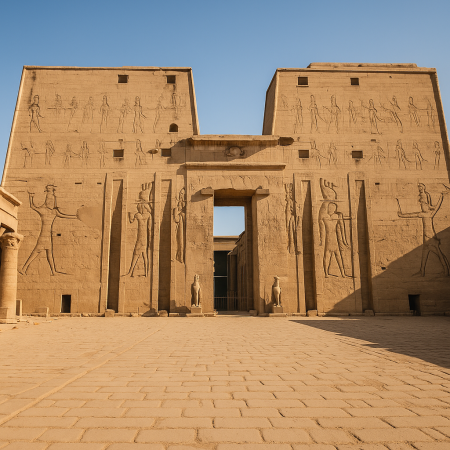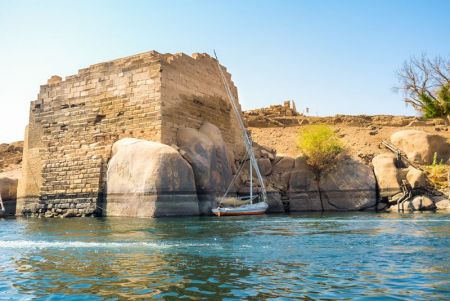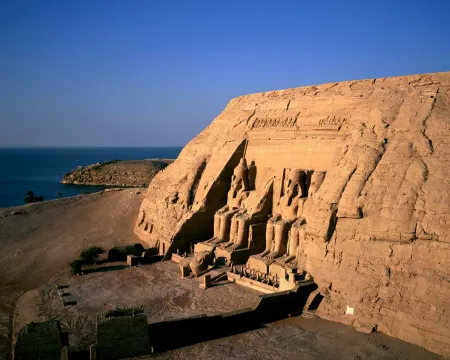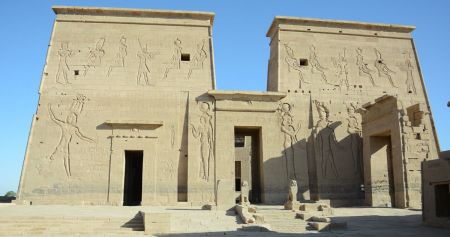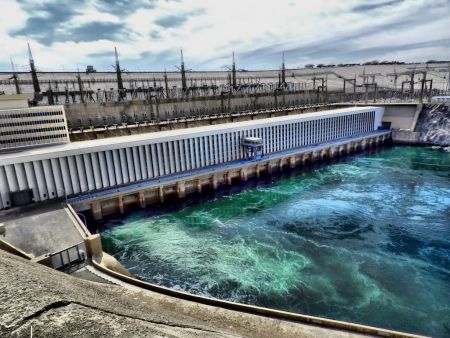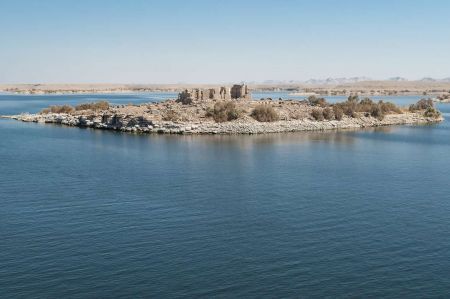Edfu Temple
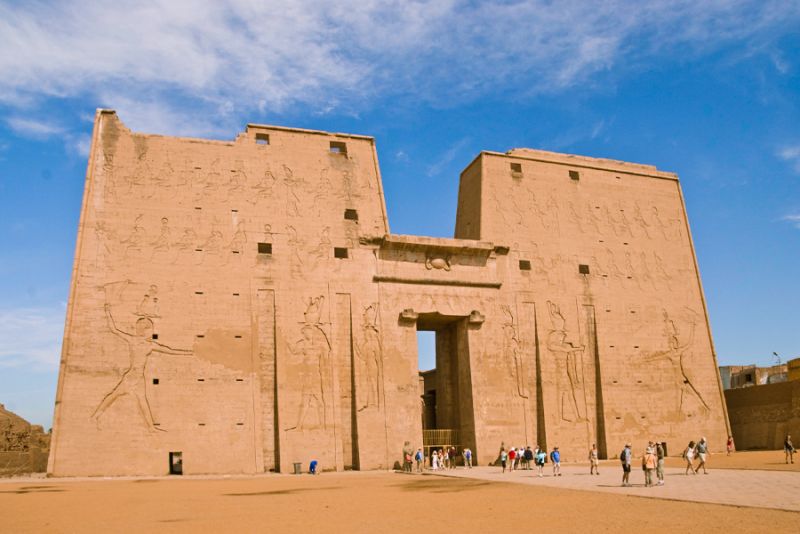
On the west bank of the Nile in Upper Egypt lies one of the most remarkably preserved temples of the ancient world – the Temple of Edfu. Dedicated to Horus, the falcon-headed god of kingship and the sky, Edfu Temple is a towering testament to Ptolemaic ambition, religious devotion, and ancient architectural genius. Built between 237 and 57 BC during the reign of the Ptolemaic dynasty, this colossal structure served as a spiritual hub and a symbol of divine power in ancient Egyptian culture.
Today, Edfu Temple stands as one of the most intact temples in all of Egypt, a true jewel of the Nile that continues to captivate archaeologists, travelers, and historians alike. With its immense pylons, sacred reliefs, and intricate inscriptions, the temple unlocks an unparalleled glimpse into the religious life of ancient Egypt. Every stone, corridor, and sanctuary tells a story — of gods and kings, rituals and legends, wars and celestial myths. Whether you're a seasoned Egyptologist or a curious traveler, visiting Edfu offers a journey through time to witness one of the most awe-inspiring monuments of the ancient world.
Historical Significance of the Temple of Edfu
Built During the Ptolemaic Era
Construction of Edfu Temple began under Ptolemy III Euergetes in 237 BC and was completed almost two centuries later by Ptolemy XII Neos Dionysos. Despite being constructed by Greek rulers, the temple reflects a strict adherence to traditional Egyptian religious design, underscoring the dynasty's desire to legitimize their rule by connecting to Egypt’s ancient spiritual heritage.
Role of Horus in Egyptian Mythology
The Temple of Horus at Edfu commemorates the divine battle between Horus and his uncle Seth, who murdered Horus’ father, Osiris. This myth was central to the temple's function and layout, with specific rooms and inscriptions narrating the story. The temple acted as a place for annual festivals and reenactments, reaffirming the divine legitimacy of the ruling pharaohs.
Architectural Masterpiece of Ancient Egypt
Imposing Pylons and Courtyards
The monumental entrance, or pylon, stands nearly 37 meters high, adorned with reliefs of Pharaoh Ptolemy VIII striking down enemies under the gaze of Horus. As you pass through the grand gateway, you're greeted by a vast open courtyard surrounded by elegant colonnades — a breathtaking space that once hosted public ceremonies.
Hypostyle Hall and Inner Sanctuaries
Moving deeper into the temple, the Hypostyle Hall boasts 12 massive columns crowned with lotus capitals, leading to the inner chambers where only priests could enter. The walls here are blanketed with hieroglyphs and scenes of religious rituals, including offerings to Horus, purification rites, and sacred chants.
Naos of Horus and Sacred Boat Shrine
At the heart of the temple lies the Naos – the sanctuary housing a black granite shrine believed to have held the statue of Horus. Nearby, a replica of the sacred barque (boat) used during festivals reminds visitors of the ceremonial processions once held along the Nile.
Edfu’s Religious and Cultural Importance
The Festival of Victory Over Seth
One of the temple’s most significant festivals was the annual reenactment of Horus’ triumph over Seth. The ritual involved processions, symbolic battles, and the sacred union of Horus and Hathor (goddess of love and music), whose temple at Dendera played a key role in the festivities. These celebrations reinforced the cosmic order and the pharaoh’s divine mandate.
Temple Inscriptions and Ancient Calendars
Edfu Temple is a treasure trove of ancient religious texts and mythological lore. It features the most complete temple inscriptions in Egypt, including calendars, offering lists, and divine hymns. These texts serve as vital resources for understanding ancient Egyptian theology and priesthood structure.
Rediscovery and Modern Conservation
Excavation by Auguste Mariette
For centuries, Edfu Temple lay buried under sand and silt. It wasn’t until the 19th century that French archaeologist Auguste Mariette began excavating the site, uncovering one of Egypt’s most pristine ancient structures. His work helped spark a broader fascination with Egyptian antiquity.
Present-Day Tourism and Preservation
Today, Edfu Temple is a central stop on Nile River cruises between Luxor and Aswan. With increased visitor traffic, conservation efforts have intensified to protect the temple’s sandstone walls, reliefs, and statues from pollution, erosion, and environmental damage.
Visiting the Temple of Edfu
Getting There by Nile Cruise or Road
Most visitors arrive at Edfu via Nile cruise ships that dock near the city, followed by a short carriage ride to the temple. Alternatively, it can be reached by car or train from Luxor or Aswan, offering flexibility for independent travelers.
Best Time to Visit Edfu
The best time to visit Edfu Temple is during the cooler months from October to April, when temperatures are more manageable for exploration. Early mornings or late afternoons provide ideal lighting for photography and a quieter atmosphere for reflection.
What to Expect at the Site
Visitors can explore various temple areas, including:
-
The Pylon Gateway
-
Open Court
-
Hypostyle Halls
-
Sanctuary of Horus
-
Birth House (Mammisi)
-
Nilometer and Sacred Lake
Hiring a knowledgeable guide is highly recommended to fully appreciate the symbolism and stories engraved in the walls.
Treat yourself to the finest Luxury Nile Cruises
Interesting Facts About the Temple of Horus
Largest Temple Dedicated to Horus
Edfu is the largest and most important temple dedicated to Horus in all of Egypt, surpassing smaller shrines in both scale and preservation.
Unique Ceiling Zodiac
In the temple's library room, a partially preserved ceiling shows astrological figures and zodiac symbols – evidence of Egypt’s ancient fascination with the heavens.
Hidden Chambers and Sound Technology
Some scholars believe that hidden chambers in the temple were designed to create sound illusions, allowing priests to communicate with worshippers through unseen “divine” voices.
Why Edfu Temple Remains a Bucket-List Destination
The Temple of Edfu isn’t just another ruin — it’s a living chronicle etched in stone. With its grand design, mythological significance, and exquisite state of preservation, it’s a must-see for history lovers, spiritual seekers, and cultural travelers. Whether you’re tracing the footsteps of gods or marveling at ancient architecture, Edfu never fails to leave a lasting impression.
Frequently Asked Questions About Edfu Temple
What is the Temple of Edfu famous for?
The temple is renowned for being the most well-preserved ancient Egyptian temple and for its dedication to Horus. It's also celebrated for its detailed inscriptions and colossal architecture.
Who built the Temple of Edfu?
The Ptolemaic kings, starting with Ptolemy III in 237 BC, constructed the temple over nearly two centuries, finishing it under Ptolemy XII in 57 BC.
What myths are associated with Edfu Temple?
The temple centers on the mythological battle between Horus and Seth and the annual festival commemorating Horus' victory.
How large is the Edfu Temple?
The temple stretches over 137 meters in length and its pylon rises 37 meters, making it one of the largest temples in Egypt.
Can I visit Edfu Temple independently?
Yes, you can reach Edfu by train, taxi, or private tour, although many choose to visit as part of a Nile River cruise.
Is photography allowed in the temple?
Photography without flash is generally allowed. However, certain inner sanctuaries may have restrictions, so it’s best to check with local guides.
Are there guided tours at the temple?
Yes, professional guides are available on-site or can be arranged in advance for deeper insights into the temple’s artwork and mythology.
Final Thoughts – Edfu Temple’s Enduring Legacy
The Temple of Edfu is more than a monument — it’s an extraordinary blend of art, theology, astronomy, and architecture. Preserved against the odds of time and nature, it stands as a proud reminder of Egypt's spiritual and cultural grandeur. If you’re charting a journey along the Nile, let Edfu Temple be a highlight — a place where legends were carved, gods were worshipped, and the pulse of ancient Egypt still echoes today.



